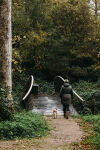Windesheim is an estate of approximately 660 hectares located near the town Windesheim in the Dutch region of Overijssel, south of Zwolle. The history of the estate dates back to the fourteenth century. The accompanying park was designed in 1789 by the Dutch landscape architect Jacob Otten Husly. In the heart of the estate are the remains of Huis Windesheim, an old estate house. The historic buildings on the site, as well as the monumental fences, bridges, gardens, and garden ornaments are protected national monuments.

Windesheim Estate
Hidden Treasures

Exploring the Historic Estate

Connecting Past and Future
With the construction of the park bridges, an interesting layer of ‘garden jewellery’ has been added to the estate in the style of Husly’s romantic park design. The eight new bridges are important landmarks on the walking route and are part of the landscape. By following the shape of the meandering path structure, the bridges accompany the carefully programmed walking route. The Ruin Bridge is an exception; this structure has been designed as a viewing platform above the moat, which offers a view of the remains of the historic mansion. It is a unique viewpoint where the different historical layers of the estate become clearly visible.
All bridges, except the smallest, have an integrated bench as a resting point on the route. The bridges play a strategic role as viewpoints by guiding the passenger’s gaze through the landscape. Due to the asymmetrical placement of the benches on a number of bridges, the spectator’s view can be intentionally directed by its orientation. As a result, the most beautiful places of the estate are highlighted and surprising new perspectives are being displayed to the viewer.

Creating Seamless Integrations
By using Corten steel, the bridges appear and disappear in the landscape. On the one hand, the brown rust colour of the material blends in seamlessly with the forest, but on the other hand, the material is fairly rough and sharp, which offers a contrast with its environment. The white railings reinforce that contrast and accentuate the bridges and their leading lines. The deck features a perforated pattern that is based on a bridge constructed from wooden slats. The slits in the deck offer a small view of the water and emphasise the seamless integration of the new connections in the Windesheim estate.













